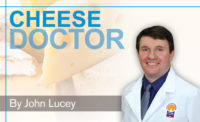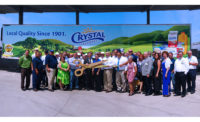Dairy packaging is in a dynamic state.
Demands from brands for attractive designs that are eco-friendly while enhancing food quality and safety is triggering the launch of new primary packaging solutions.
Technology developers, meanwhile, are engineering packaging systems that are simpler to maintain and provide processors with greater operating efficiencies.
The greater interest by brands in using packaging as marketing tools will lead to further upgrades, analysts say.
“Dairy processors strive to develop packaging that is easy to use, while also being distinctive enough to be eye-catching and jump off the grocery self,” says Jonathan Veins, North American sales manager for Osgood Industries LLC, an Oldsmar, Fla.-based manufacturer of inline and rotary cup filling machines for preformed containers.
Occurring simultaneously is a shift toward sustainable packaging that includes the development of products that are either recyclable, use recycled content, or are compostable, says Tim Kieny, vice president of marketing — dairy, protein, and pet, for TC Transcontinental, a Montreal-based flexible packaging provider.
“With rising environmental concerns, the leading dairy companies are adopting eco-friendly packaging to reduce their environmental impact and to preserve natural resources,” reports IMARC Group, a Brooklyn, N.Y.-based management strategy advisory and market research firm. Such packaging formats include Tetra Packs, glass bottles, clear tubs, and squeezable pouches, the firm states.

Sustainability takes center stage
Dairy food producer Nestlé S.A., for instance, says it is seeking to eventually prevent all its packaging from ending up in landfills or becoming litter. The Vevey, Switzerland-based developer reports that 85.8% of its total packaging was recyclable or reusable in 2022; 36% was made from recycled and/or renewable materials; and its total packaging weight of 3.6 million tons was down from 4.5 million tons in 2020.
“Shoppers are connecting more with brands that are responsible from the product itself to the packaging,” Kieny says. “They want to affect change by their choices and are demanding that brands take a responsible stance.”
Such interest is leading more processors to reduce the amount of material, or lightweighting, in product packaging, which for instance, might include reducing the length of cheese packaging by 15 to 20 millimeters, says Carlo Bergonzi, product manager — Mondini Tray Seal, at Taunton, Mass.-based Harpak-ULMA Packaging LLC.
“Dairy food packaging is evolving and adapting to become an integral part of a circular economy where packaging never ends up in a landfill but is recycled and used to package the next sweet treat,” says Harrison Carney, account manager, consumer goods division, for Huhtamäki Oyj, an Espoo, Finland-based packaging developer.
Dairy processors, he notes, are seeking packaging with elements that enhance food safety and prevent food waste while contributing to a low-carbon system.
In addition to leveraging packaging with sustainable properties, operators are seeking designs with protective features. Producers, for instance, are offering yogurt in high-density polyethylene bottles sealed with either aluminum foil, laminated heat-seal closures, or low-density polyethylene caps or lids to guard the contents from oxidation and delay the fading of light-sensitive colors, IMARC Group states.
Packaging manufacturers also are providing modified atmosphere packaging with aseptic and antimicrobial properties to help extend the shelf life of dairy products up to 90 days under refrigeration storage by controlling the associated fungal contamination, IMARC Group notes.
“The evolution of dairy packaging is being driven by a combination of sustainability, innovation, and technological advancements, all of which aim to create more effective and environmentally friendly solutions,” Kieny states.

Packaging lines become more potent
This evolution includes the incorporation of sensors and inspection systems in packaging lines that allow processors to control upstream and downstream processes and maximize line performance, says Rudy Sanchez, food handling systems product manager at Key Technology, a Walla Walla, Wash.-based equipment provider.
Sensors, for instance, can collect operational data on one machine to automatically cause adjustments to other line machines without human intervention, he notes.
Such measures include the transmission of information on product flow to trigger upstream gates or diverters on distribution shakers to control feed rates, Sanchez states. Integrating plant-wide networks into lines enables processors to monitor and control the entire line from one location inside the plant as well as remotely via smartphones and other devices, he adds.
Performance, sanitation, and reliability, meanwhile, are key elements for dairy processors to consider when choosing conveying systems for packaging lines, Sanchez says.
“Processors will want to understand how the packaging supplier’s recommended solution will achieve their objectives, including transporting product and distributing and feeding other packaging machinery effectively, while maintaining the desired throughput and maximizing reliability and uptime,” he states.
Dairy product developers should team with equipment suppliers that have experience with comparable products and applications to determine the packaging system that best fits their requirements, Sanchez says.
This can include analyzing the ease of cleaning the equipment, which can be as important as its operation, Osgood Industries’ Veins notes.
“Resistance to corrosive and caustic cleaning chemicals is an absolute must,” he states. “We joke that machine sensors must resist being dowsed with a fire hose. This all should be the base line for dairy processors looking into wet packaging room equipment before even starting the traditional conversations of machine operation, efficiency, maintenance, and changeover process.”
The greater market focus on sustainability will impact packaging technology selection as well, Veins says, noting that equipment must support newer and more environmentally friendly packaging materials. “Different materials equally need evolving equipment designs,” he states, including systems that can disinfect packaging materials to eliminate mold and bacteria.

Seek the perfect fit
The optimal package attributes, meanwhile, will vary by product and are dependent on such elements as cost, sustainability, resiliency, waste reduction, and recloseability, Harpak-ULMA Packaging’s Bergonzi says.
“The idea is to align packaging with the product,” he states. A premium item will benefit from higher-end packaging, which might be rigid with more bulk, have sustainable materials, and feature peel and reseal lids, while lower-cost packaging will typically suffice for a less-expensive product, such as shredded cheese, Bergonzi explains.
Processors also will benefit from analyzing their competitors’ packaging and then determining how to effectively differentiate their selections, he adds.
The intended use and distribution of the dairy product also plays a key role in packaging selection, Veins says.
Operators, for instance, should consider if the packaging will hold dairy product for food service or retail; if it is single serve for groceries, restaurants, and institutions, or multiple use and stored in a consumer’s refrigerator after the initial opening; and if the product and package will be sent through the cold chain or require shelf stable aseptic, retort, or high-pressure processing.
“The packaging system must serve the use, look, and channel of the product through the marketplace,” Veins states.
Implementations bring obstacles
Incorporating the optimal packaging system and materials, however, can be arduous, Veins says, with higher packaging material expenses a key impediment.
“The goal to minimize costs is never ending,” he states, noting, for instance, that “we are approached at least once a week by a customer looking to replace the aluminum foil lids that seal cups” because of the greater weight of aluminum compared to lightweight plastic foils, which affects shipping expenses, along with uncertain aluminum availability.
Utilizing packaging that is recyclable, reusable or incorporates post-consumer recycled plastics while maintaining functionality can be burdensome as well, TC Transcontinental’s Kieny says. This is resulting in the greater consideration of innovative technologies or materials “that change what is possible,” he notes.
Processors seeking the most effective packaging also must tackle such issues as compatibility with existing equipment; meeting evolving consumer preferences and governmental regulations; and managing supply chain disruptions, he states.
Kieny adds that because of the stronger interest in sustainable solutions, “there's going to be more demand for transparency and visibility within the supply chain and it will require collaboration with suppliers and partners to present that information to the consumer.”
Providing data on sustainability and other elements on product packaging, for instance, will help improve the marketability of the product, IMARC Group notes.
The growing demand for sustainable packaging that also enhances food safety and food quality will likely lead to further changes in packaging design, materials, distribution, and shelf presence, Veins says.
This includes the launch of more sanitary equipment options that strengthen food safety by reducing areas where pathogens can accumulate and are easier to clean. Among such elements is the elimination or minimization of metal-to-metal overlaps, the use of 100% welded seams, and the incorporation of removable equipment parts, Key Technology’s Sanchez says.
Effective designs also will have the flexibility to support greater processing speeds as operations evolve, Sanchez notes. Yet, it also will require a willingness by processors to invest and embrace modern technologies and solutions, Kieny adds.
“The intelligent packaging system is capable of winding up intelligent functions including sensing, tracing, detecting, recording, and communicating,” states Lewes, Del.-based Verified Market Research. “This system in dairy products packaging can help to improve quality and enhance safety. With intense competition and a complex supply chain globally in the dairy packaging market, companies are deploying innovative solutions to provide better protection and safety.”
Indeed, the evolution of packaging will build upon the recent movement from glass bottles to polyethylene pouches, paperboard cartons and tins, Tetra Packs, and aluminum cans, IMARC Group reports.
The firm adds that packaging will continue to play “a vital role in the distribution of dairy products which are highly perishable in nature,” with effective packaging protecting the contents from contamination.



